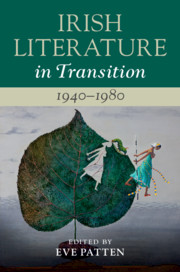Book contents
- Irish Literature in Transition, 1940–1980
- Irish Literature in Transition
- Irish Literature in Transition, 1940–1980
- Copyright page
- Contents
- Contributors
- Series Preface
- General Acknowledgements
- Introduction
- Part I After the War: Ideologies in Transition
- Part II Genres in Transition
- Part III Sex, Politics and Literary Protest
- Part IV Identities and Connections
- Chapter 13 State, Space and Experiment in Irish-Language Prose Writing
- Chapter 14 Anglo-Ireland: the Big House Novel in Transition
- Chapter 15 American–Irish Literary Relations
- Chapter 16 ‘Home Rule in Our Literature’: Irish–British Poetic Relations
- Part V Retrospective Frameworks: Criticism in Transition
- Index
Chapter 14 - Anglo-Ireland: the Big House Novel in Transition
from Part IV - Identities and Connections
Published online by Cambridge University Press: 28 February 2020
- Irish Literature in Transition, 1940–1980
- Irish Literature in Transition
- Irish Literature in Transition, 1940–1980
- Copyright page
- Contents
- Contributors
- Series Preface
- General Acknowledgements
- Introduction
- Part I After the War: Ideologies in Transition
- Part II Genres in Transition
- Part III Sex, Politics and Literary Protest
- Part IV Identities and Connections
- Chapter 13 State, Space and Experiment in Irish-Language Prose Writing
- Chapter 14 Anglo-Ireland: the Big House Novel in Transition
- Chapter 15 American–Irish Literary Relations
- Chapter 16 ‘Home Rule in Our Literature’: Irish–British Poetic Relations
- Part V Retrospective Frameworks: Criticism in Transition
- Index
Summary
The accretion of Anglo-Irish identity around the symbolic locus of the ‘Big House’ is in many respects a distraction from any socio-economic reality, yet this tradition remains compelling within an Irish literary narrative. This chapter considers the deployment of the genre in relation to the work of Elizabeth Bowen, as it eventually becomes used as a motif through which to explore themes that could scarcely have been thought of when the original Ascendancy homes were built. It queries the accepted relationship between literary setting and social caste, and outlines fresh critical parameters for this recurrent idiom. Initially reviewing works such as Aidan Higgins’s Langrishe, Go Down, published in 1966, J. G. Farrell’s Troubles (1970) and John Banville’s Birchwood (1973), the first part of the chapter argues that these writers reinvigorated Big House fiction through stylish interventions in language and a thematic turn towards metafiction. It then discusses how in the 1970s, under the impact of revisionism, events in the North and the growth of feminism, Jennifer Johnston and Caroline Blackwood reinvented the Big House narrative of Anglo-Irish decline, subverting and parodying the conventions of a genre that until then had seemed stable and familiar.
Keywords
- Type
- Chapter
- Information
- Irish Literature in Transition, 1940–1980 , pp. 255 - 271Publisher: Cambridge University PressPrint publication year: 2020
- 11
- Cited by

